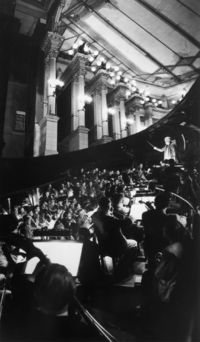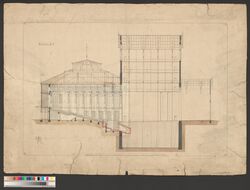Wagner termed the space between the 1st and 2nd proscenium in the Bayreuth Festival Theatre the ‘mystic gulf’. The sound cover hides the orchestra, making it invisible to reinforce the stage illusion by removing a visual distraction.
The wooden sound cover consists of two parts: a horizontal sound screen attached to the front of the stage and almost completely covering the orchestra pit from behind, and a shell-shaped screen between the orchestra pit and the auditorium, which reflects the sound rising from the orchestra pit towards the stage and prevents direct sound from reaching the auditorium.
Bayreuth’s orchestra pit, which is unique in the world, descends in terraces on six steps to the back of the stage and is completely invisible to the audience. The result of this exclusively indirect sound distribution in the auditorium is a mixed sound that makes it virtually impossible to locate not only individual instruments but the entire orchestra. Instead, an orchestral sound is achieved that spreads ubiquitously throughout the room.
The new operatic form, Wagner’s conception for the Work of Art of the Future, was to lead to a new architecture and new theatre techniques. In 1871, after an unsuccessful attempt to build his theatre in Munich with the architect Gottfried Semper, Richard Wagner identified the city that was to house it: Bayreuth, halfway between Berlin and Munich, the two great German cities (Q5086).
The poverty of the materials used in the construction and the absence of ornamentation are the two points Wagner emphasises in his description of the new building, which aims to establish a relationship with the spectator very different from that of the great bourgeois opera houses of the period such as Charles Garnier's Paris Opera (Q365), opened only a year before. But it is not only these aspects that distinguish Bayreuth from the great opera houses of the 19th century. Other innovations differentiate the space.
The first of these is the darkening of the auditorium during the performance. The spectator was to concentrate on the reception of the work of art; nothing was to be a distraction. The value of the theatre as a social meeting place was irrelevant for Wagner. In the auditorium one is not there to see and be seen, to whisper between aria and aria, one is there to contemplate, to listen devoutly to the Wagnerian Gesamkunstwerk (Total Work of Art).
The second innovation is the arrangement of the audience in an amphitheatre, in the manner, though not exactly in the manner, of the Greek theatre. Here, too, the Festspielhaus stands as a landmark against the teatro alla italiana: the classical amphitheatre versus the horseshoe; the unitary image of the people, of the nation, das Volk, attending, united with the work of art, as opposed to the compartmentalisation in boxes, as in theatres such as La Scala in Milan (Q2610), with its fragmented ownership.
The final innovation consists in hiding the orchestra in a pit, concealing the ‘technical apparatus of music’, the musicians playing their instruments, so reinforcing the spirituality of the music, which was to envelop the hall without being visible where it came from. Walter Benjamin contrasted this operation with Bertolt Brecht’s epic theatre. For Benjamin, the ideal epic theatre space should be raised on a platform like a boxing ring, unlike that of Wagnerian opera, in which the unfathomable, mystical abyss separates the dead from the living, the stage from the hall, the ideal from the real.
The separation of the world of the stage from that of the audience is strengthened by the pilasters that run through the hall, as if they were a sequence of proscenium arches, producing an optical effect that adds depth to the scene, mysteriously distancing it from the expectant community. Everything in this theatre is designed to accentuate the mystical abyss between the auditorium and the stage: the life of Art. The new operatic form, the Work of Art of the Future, was to lead to a new architecture, while the orchestra – the very essence of opera – was to become invisible, and music was to be detached from the living, breathing means of its creation. The invisible orchestra, and the invisible – or at least intangible – stage was later to find its fullest realisation, as Susan Sontag pointed out (Q30607, 157), in that immaterial stage, the cinema screen.


